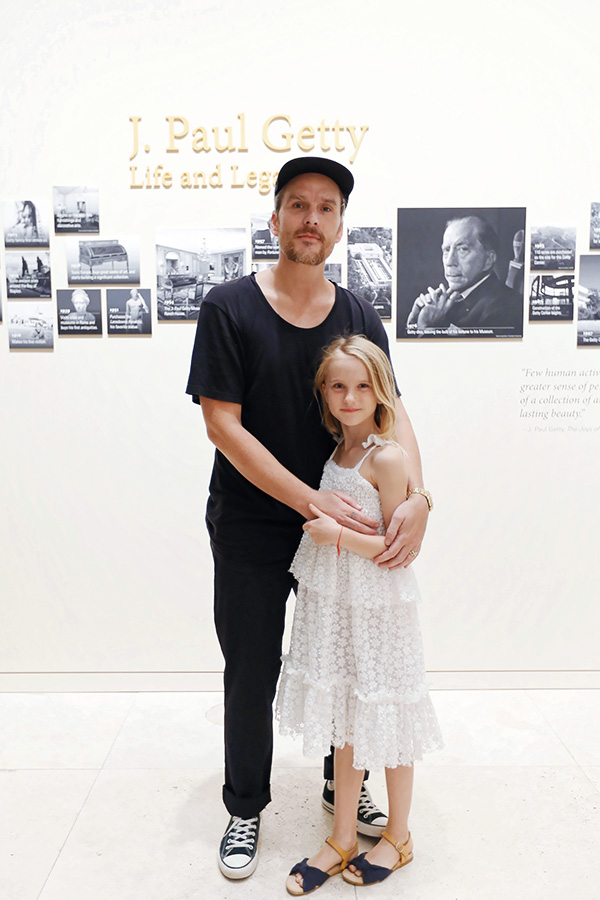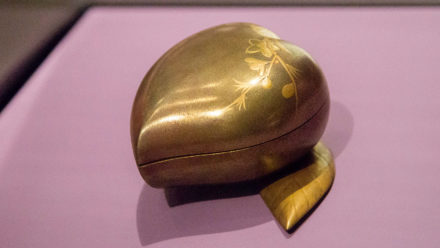
Balthazar Getty and his daughter, June, in the J. Paul Getty: Life & Legacy installation at the Getty Center. Photo: Ryan Miller/Capture Imaging
Jean Paul Getty’s death in 1976 was followed by a stunning surprise: he had left the lion’s share of the fortune he made in oil to support “a museum, gallery of art and library for the diffusion of artistic and general knowledge.” Today, the J. Paul Getty Trust is a conservation institute, research center, foundation—including an art-publishing arm—as well as a museum. It supports art conservation and research across the globe.
Getty also left behind a family. Famously married five times, he had five sons. Among his great-grandchildren is Balthazar Getty, an actor, fashion designer, and DJ who lives in Los Angeles.
An interactive installation devoted to J. Paul Getty’s life and legacy opened this past fall at the Getty Center, and Balthazar was at the opening—with 22 other Getty relatives. What is it like to be the great-grandson of the man whose name is synonymous with one of L.A.’s major landmarks? We chatted about his thoughts on Mr. Getty and what it’s like to bear a name not only associated with great wealth, but also with a dedication to art.
Amelia Wong: Your great-grandfather died the year after you were born. Do you remember hearing stories about him as a child?
Balthazar Getty: Yes. I grew up very differently than what people would probably think. You hear a name, a famous name, and you have some preconceptions about what that sort of upbringing would be like. My mother was a hippie and an artist, and I lived in a teepee in a Zen center in Marin County. I didn’t grow up with any sense of wealth and this idea of “Mr. Getty.” It’s a really hard thing to articulate because people ask: “What’s it like being a Getty?” It’s like me asking you what’s it like to have your surname. It’s just what I know, you know?
I can remember at a pretty young age starting to ask questions about my family and seeing photos. I can’t remember one moment where I was like, “Wow, my great grandfather was Paul Getty!” It was more just a growing awareness, and then when I was sort of a preteen or teen, really learning more about the Villa, starting to get stories from my grandmother and aunts and uncles about what it was.
He’s buried at the Villa, which I don’t know if people even realize. [J. Paul Getty is buried at a private grave site on the surrounding property.] I can remember being pretty young and visiting the grave site. Then, when my kids were born, taking them there as well.
Of course, I heard all of those stories that he never physically visited the Villa, and that he would have the construction filmed and sent to him in England and he would watch the film. If one little thing was out of place he’d fire somebody. All those wild stories. So many of them are sensationalized, either in your own imagination or in the way you hear the stories told.
For the most part, the older I got, the more I was able to take pride in my family history, and the more I was able to find out what really happened. It’s been interesting; I learn more every day. It’s funny because, while the Center’s been putting this installation together, we as a family have also been looking into the history. We have an annual family get-together. Every year we meet and one of the things my uncle and I put together—starting about four years ago—is a history lesson for the younger generation: Where did the money come from? Who was this man? Who were his parents? How did the museum start? It’s just interesting. We’ve been scouring the internet and asking questions and doing a lot of the same things you guys have been doing. I know we’ve even shared some literature and stories [with Getty staff].
It actually took four years to tell the entire story. Last summer we shared the final piece, and then it all sort of culminated with the night when we were all up at the Center for the opening of the installation. There were five generations of us there. My great grandfather’s ex-wife, Teddy, who is 103, was there. It was pretty special. Five generations all being there after we’ve been hearing all these stories. It’s just interesting that as the family’s learning about it, the public is learning about it as well. It’s kind of funny how the timing worked out.
Speaking about the installation, what were your impressions?
We got to go a few months ago and see it very early on; we helped test the beta version [of the interactive touch screens]. I saw the space and talked to Merritt [Price, head of design at the Getty Museum and one of the curators of the installation] and other people on the team. I found it really fascinating. Of course, I know a lot of the stories. I knew them growing up. I’ve read most of the books, but there were a ton of photos I’d never seen.
One thing we really want as a family to have people understand is that Paul was really a very bright, very knowledgeable collector. There’re great stories about my great-grandfather going to meet an art dealer and he would come up with a fake name because, of course, if he went as Paul Getty the price was going to skyrocket or the dealer might not take him seriously. There’re some great stories where he actually met dealers and they struck up a conversation about antiques or a painting or whatever, and the other person thought that my great-grandfather was also an art historian, a professional.
Paul was not a wealthy man who bought art for the prestige. He was a man who knew that art inside and out, and had a deep, deep understanding of art history and provenance. Art collecting was a great passion for him. It wasn’t a vanity project. There’s much, much more to it than that.
You touched upon this a bit, but the installation is also about Getty’s legacy. Do you feel personally connected to that legacy?
Yes. Absolutely. When you’re younger, I think you rebel against these sort of things because you want to create your own identity and nobody wants to be seen as the great-grandson, or grandson, or son of anybody. You want to be your own man and create your own legacy. I think I rebelled to some extent when I was younger, but the older I get the more pride I’m able to have in my family’s history. Being at the Getty Center the other night when Tim [Potts, the director of the Getty Museum] was speaking about what the Getty is able to do thanks to its endowment—it’s an incredible, incredible thing that Paul put together.
As a family we feel incredibly proud. It’s not about showing off. It’s not about gloating. It’s really just having pride in what Nonno was able to do. I do feel an incredible connection. This was my great-grandfather: I’m Paul Balthazar Getty.
Does the Getty inspire you? Do you visit the Center or Villa often? Do you have a favorite artwork?
I don’t know if I have a favorite artwork in the collection. I love all the Renaissance paintings, all the 15th-century Italian stuff. Who doesn’t love that, I guess?
I don’t go up as much as I should. It’s this gift right on our doorstep. It’s a great place to just go get a coffee and bring a book and go sit in one of those great spots and watch the sunset. You don’t have to go and see the entire collection. I like to go to museums and just look at a few pieces and enjoy the space, you know? Hopefully more and more my kids and the younger generation embrace it.
Do you have a vision for how you want to see the Getty develop?
I want it to continue to grow, to be relevant. I want it to continue to have exhibitions and installations of contemporary artists that can help bridge the gap for the younger generation. I’d love to see it continue to grow in the digital area as well.
Ultimately, it’s its own thing. It has its own legacy and it will be here long after I’m gone. I hope that it continues to have a connection to the city, so if you think about Los Angeles, you think about the Getty Center and the Getty Villa as being a big part of that story.
Here’s my last question. If you could have dinner with your great-grandfather, what would you want to talk about?
I’d want to hear all the stories, the great adventures. He was really an inquisitive man who at a young age, as a kid, was living in Bartlesville, Oklahoma in a “cowboy and Indian” town, with a brothel on one corner and all types of people chasing the oil rush. He was there wandering around all of these incredible places. Then at a very young age, the family did a huge tour through Europe in a car, well before people were really doing that. We love to tell stories in the family and I’d love to hear about all the stories firsthand, being in Oklahoma that young and then coming to Los Angeles and just hearing how it all happened.




thank you so much to timothy potts and merritt price and the great getty staff for creating the life and legacy exhibit and for unearthing and shedding a more natural light on my grandfather …thank you for making it possible to strip some of the myth that was setting like stone…thanks balthazar for your thoughtful contribution …
Aileen, thank you for the kind words. I’ve passed them on to Tim and Merritt.
Thanks for setting many rumors to rest /and I look forward to the future with the Getty Families to do the best for the Trust and the Arts etc.
We really need the Arts to flourish to offset this strange Political Cloud were under / that seems to think this is all there is to Life on this Planet as we know it! Thanks for listening RSN
What a fascinating read! Balthazar Getty is a wonderful, inquisitive and admiring relative who earnestly shared his own interest in the ‘family affairs’. And we, the readers, gained some interesting facts not widely known. The Getty Staff has given all of us a fascinating narrative of Mr. Getty’s history and life in this fact and photo Exhibit currently on view. And we, visitors and all who are connected to the Getty Center are the beneficiaries.
Mr Getty,
Thank you for sharing your thoughts and personal insights. It’s wonderful that you are willing to give us these memories.
As a museum enthusiast and a prospective Graduate student in Museum Studies, I am thrilled to be visiting The Getty Center for the first time. This will be a very important visit for me and I am appreciative of your Great Grandfather ‘s contribution.
All the best.
Sincerely,
Annice Okos
I love hearing stories like the one of J. Paul Getty. Amazing! Started from nowhere and accumulated a world renowned collection of art. The Getty is not just a museum, it’s an experience. When friends visit Los Angeles, we go to the Getty; when we want a relaxing afternoon and a fantastic meal, we go to the Getty. It’s a magical place. And the staff are always polite and helpful.
This was very interesting to read. Thank you for posting.